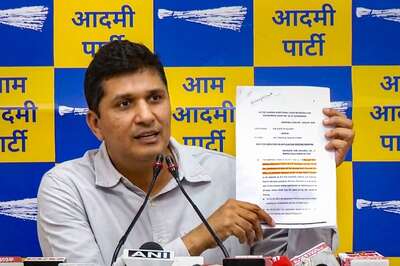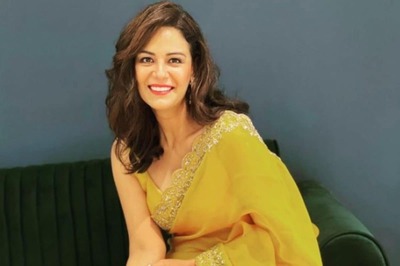
views
Mumbai, the city that never sleeps, once came to a standstill during its battle against the deadly Covid-19 pandemic. The city, back in its insomnia mode after having put up a brave fight against the novel virus, has become the first city in the country to have fully vaccinated its adult population against Covid-19.
In its journey from being one of the worst hit cities in India to now being the first one to vaccinate its entire population above the age of 18 against the virus, Mumbai has seen and gone through its rather generous share of ups and downs.
It was on March 11, 2020, that the city detected its first case of the virus that the world was still trying to figure out back then. More than two years on, Mumbai has seen over a million cases, more than 19,000 Covid deaths and, most importantly, a brave fight against the pandemic to get back on its toes.
Take a look at Mumbai’s Covid fight journey:
The first cases
Mumbai, known as India’s financial capital, reported its first case of novel coronavirus on March 11, 2020, when the virus was still a mystery and had not even got its name, ‘Covid-19’.
The first two cases of coronavirus in Mumbai had come in close contact with two Pune residents who were the first confirmed cases of Maharashtra and had tested positive after returning from Dubai.
The authorities concerned had kick started an aggressive contact-tracing drive back then in the hope to stem the spread of the virus but things soon worst was yet to come.
When Covid situation nosedived in Mumbai
Since reporting the first case, the coronavirus graph went north and the Covid situation nosedived in the city which reported it’s highest daily case count at over 20,000 in January this year, when India was going through its third wave of the pandemic.
Before this, Mumbai had logged the highest-ever 11,163 Covid-19 cases on April 4, 2021, during the second wave.
From lockdowns to endless containment zones , Mumbai, that became one of the worst-hit cities by the pandemic in the country, fought tooth and nail to cut the chain of transmission of Covid-19. The city pulled itself together after each Covid wave and now finally seems to be back to its bustling normalcy.
The city even saw local trains, considered its backbone, suspended for over a year due to the pandemic.
Shortage of hospital beds, oxygen during second wave
Like other parts of the country, Mumbai too was witness to horrifying cries of helpless people trying to get oxygen and hospital beds for their loved ones during the devastating second wave of Covid-19.
Maharashtra, however, quickly overcame the shortage by diverting oxygen tankers from states that had more.
This was also the time when the city witnessed multiple hospital fires, some that broke out at facilities meant to cater Covid patients. At least 11 people died and 10 others were injured after a fire broke out at a private Covid-19 hospital in Bhandup West on March 26, 2021. Almost a month later, a fire broke out at an ICU of the Vijay Vallabh Covid care hospital in Virar on April 23, leaving 15 dead. In under a week, at least four people died in a fire at a non-Covid healthcare facility in Thane.
Covid outbreak in densely-populated Dharavi, India’s largest slum
Mumbai’s slum colony of Dharavi, once a coronavirus hotspot and a challenge for municipal authorities in implementing containment measures, is now free of Covid-19, nearly two years after reporting the first case of the infection.
The sprawling and congested shanty town, said to be Asia’s largest, achieved the distinction last month when no new coronavirus patient was found in Dharavi and at the same time there was no active case in the area, a senior Brihanmumbai Municipal Corporation (BMC) officer had said.
The area being densely packed, the detection of first case of coronavirus in Dharavi in April 2020 was a matter of concern. Dharavi has a population of around 6.5 lakh and is spread across 2.5 sq km area. However, Mumbai authorities’ trace-track-test-treat method helped them to stop the virus from spreading to an incontrollable level.
Talking about how the ‘Dharavi Model’ helped, Kiran Dighavkar, assistant municipal commissioner of G-North ward that houses Dharavi, had said last year that despite a slow spread of the virus in December 2020 and early January 2021, “we continued with comprehensive testing and tracking of cases in Dharavi”.
With the onset of the Covid-19 second wave in February 2021, the Dharavi Model was activated again to stem the spread of the infection, he said. “Door-to-door screening of people with symptoms, aggressive testing, regular screening and testing of Dharavi residents who work in different parts of Mumbai, including delivery personnel, industrial workers, helped to control the spread of the pandemic,” Dighavkar said.
Dharavi has a population of 6.5 lakh, which means 2,27,136 people living per sq km. Social distancing was next to impossible in Dharavi, where families of eight to 10 people live in 10×10 hutments.
Mumbai first city to fully vaccinate all adults
Having fought all the battles, Mumbai has now become the first city in India to fully vaccinate its eligible adult population against Covid-19.
The Brihanmumbai Municipal Corporation (BMC) said it has administered 92,42,888 second doses as on Tuesday against the original target of 92,36,500.
BMC executive health officer Mangala Gomare confirmed that Mumbai has achieved the full vaccination milestone, more than 14 months after the nationwide roll-out of the coronavirus inoculation drive. “So far, 1,02,96,917 first doses have been administered in the 18 plus segment, achieving 111 per cent vaccination of this age group. In the 12 plus population, the city has achieved 93 per cent vaccination,” an official said.
So far, 94,92,511 people have been given second dose of the vaccine out of the originally targeted 1,02,44,843 people, the official added.
Read all the Latest India News here




















Comments
0 comment